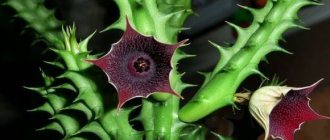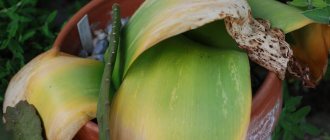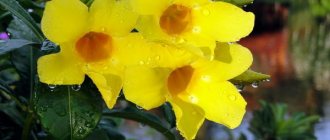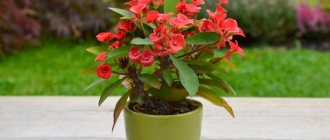Exotic lovers will not pass by gloriosa.
This plant goes by many names. Some call it the “Fire Flower” , due to its variegated color and shape reminiscent of flames, as well as its habitat in a tropical climate.
Others call it the "Queen of Flowering Creepers" due to its flexible shoots and vibrant greenery. Still others say that gloriosa is the heart of Africa .
Description of the plant
Gloriosa (from the Latin “Gloriosus” - glorious, illustrious ) is a herbaceous perennial with a tuberous rhizome. The shoots are flexible, thin and very fragile.
They cannot curl, but have large, bright green, flat leaves with a pointed tip, which are called lanceolate. However, it belongs to the climbing vines.
The plant grows no more than 3 m . Arrangement of leaves three in a row or opposite each other. The buds grow on a long stem and have a double color. They bloom in the cavities of the upper leaves.
Petals (up to 7 pieces in 1 flower) rush down, perianth leaves stretch upward. They have a long (up to 10 cm), wavy edge, which affects the appearance of the bud depending on the variety.
The stamens are located in a prominent place, under the bud .
The finish is yellow with a hint of orange or red. The plant blooms throughout the summer season, and some varieties bloom in September. Interesting Facts! The plant is native to Sri Lanka, Nepal, Asia and Africa. Considered a symbol of the Indian state of Tamil Nadu and a nationality in Zimbabwe, it is therefore protected by law. In Australia, the flower is called a poisonous weed, which leads to the death of animals and plants.
Types of Gloriosa
Gloriosa luxurious or magnificent (gloriosa superba)
Grows in clay soil. Shoots reach up to 2 m.
The leaves grow in 3 pieces on one stem measuring 10x3 cm. The flowers are red, wavy, the flower border is yellow. Petals are curved up to 8x2.5 cm.
Gloriosa simplex
This type of flower reaches a height of up to 3 m.
The stems are long, thick and branched. The bud has 6 even petals with wavy edges up to 5 cm. The color is yellow-green.
Rothschild's Gloriosa (gloriosa rothschildiana)
The stem is straight and large, but curls with age.
The leaves are flat with a pointed tip up to 8 cm. The petals are bent, wavy in shape. The color ranges from pink to bright red, the base is yellow.
Gloriosa Carson
Or a dwarf plant, up to 1 m high.
The stem is knotty and thin. Petals with wavy edges. The color of the flower is crimson with a yellow streak along the edge. The inside is brownish-purple.
Gloriosa Gren
The only difference from its predecessors is that the petals are straight, smooth, and curved upward. The color is monochromatic, lemon-colored.
Yellow Gloriosa (gloriosa lutea)
Like Grena's gloriosa, it has yellow petals. They differ in that the petals have wavy edges and a soft green base.
Gloriosa citrine
A variation of Rothschild. It differs from it in its large petals of bright yellow color and a blurred red base. The petals are wavy, the leaves are lanceolate.
Interesting! At home, only Gloriosa splendid (magnificent) germinates. It was this species that made it possible to develop 6 more varieties of the plant.
Botanical description[edit]
Vegetative organsedit
A climbing herbaceous plant with a horizontal rhizome. The shoots are branched, leafy, up to 2 meters long, clinging to supports with tendril-shaped leaf tips. The leaves are sessile, alternate, sometimes opposite or in whorls of 3, narrowly ovate-lanceolate with a thin apex spirally twisted like an tendril.
The tubers are underground, spindle-shaped, often V-shaped, with one growth bud, without roots (the roots develop in the root collar, at the base of the stems), covered with a thin golden-brown silky skin, fragile, non-wintering.
Generative organsedit
The flowers are arranged singly on long stalks in the axils of the leaves. The flowers are large, actinomorphic, bisexual. The perianth is separate to the base. Its six leaves are bent towards the peduncle, lanceolate, wavy; the outer side is pink, the inner side is two-colored: the base is yellow, the upper part is bright red. There are six stamens. The stamens are radially spaced, subpistillate, resembling the spokes of a wheel. Large oblong anthers are opened by a longitudinal slit. The ovary is superior, consists of three compartments, the carpels are fused only by their internal boundaries. The eggs are numerous.
The fruit is a dehiscent multi-seeded capsule.
Reproduction is by seed and vegetative (tubers). Seeds remain viable for 6-9 months.
Features of growing gloriosa at home
Location and lighting
Gloriosa is a heat-loving plant and even home conditions should correspond to natural ones.
The plant is comfortable in the sun or in bright, diffused light. Direct sunlight destroys it. In summer, it can be moved to an eastern or southern window sill, balcony or garden.
In winter, it is placed in a greenhouse or garden where there is artificial lighting close to sunlight. If the flowers were left without lighting, they are gradually accustomed to sunlight or artificial light.
Important! You should not place the plant under an ultraviolet or bright LED lamp.
Temperature
Sharp temperature instability leads to death. The main condition is to avoid placement in through rooms . In windy or stormy weather, it is better to put flowers in the leeward part of the room.
The required temperature for comfortable growth is 20-25 C. In winter, the room temperature drops to 5-10 C. A bouquet of gloriosa is transported at 6 C.
Air humidity
Flowers require high air humidity of 50 - 70%.
For convenience and constant control, expanded clay or pebbles are poured into the flowerpot stand, then filled with water and a flower pot is placed. The main thing is that the roots of the plant do not touch the water.
As moisture evaporates, humidity rises. In summer, spraying is carried out, which not only increases humidity, but also removes dust. However, during the dormant period, high humidity should be avoided.
Important! Spraying is done with boiled, warm water during hot or heating periods. Avoid getting drops on the inflorescences.
Watering
Water for irrigation should settle and be warm (neither hot nor cool). The signal for the need for watering is the dried top layer of soil and active growth.
During the hot or heating season, regular watering is required up to several times a day. It is not recommended to allow the layer to completely dry out or flood.
In autumn, when the leaves turn yellow, the volume of water for irrigation is reduced. There is no need to water the flowers after the flowers fall.
Rules of care
For beginners, growing and caring for a flower may seem difficult. It is recommended to take into account the characteristics of the plant and adhere to a number of rules.
- Temperature. A heat-loving flower, Gloriosa feels comfortable at 20-22°C during growth and flowering. Temperature changes are undesirable. With the end of flowering, the life cycle of the plant also ends - the above-ground part dies completely. It is cut off and the tubers are put away for storage.
- Lighting. Optimally - diffused light. It grows well on any window except the north one. In the south, on hot days it is recommended to shade slightly.
- Watering. Water until the soil is completely wet. Between waterings, wait until the surface of the soil in the pot dries out. Yellowing of the leaves is a signal to reduce watering. In winter, the tubers are kept dry.
- Feeding. Liquid products for flowering crops in the dosage specified by the manufacturer.
- Humidity. Within 60-70%. Spray in the morning and evening. Use boiled water. It is recommended to increase the humidity in the room by any possible means. For example, using a special humidifier.
Advice! Experienced gardeners recommend storing tubers in vermiculite or dry peat. As a last resort, they can be left in the same pot for the winter. But in the spring, the tubers must be transplanted into new soil!
Feeding and fertilizer
To ensure that fertilizing and fertilizing do not lead to empty results, you should pay attention to the soil before planting or replanting. Leaf soil + humus with the addition of peat and sand in a 2:1 ratio is ideal.
To avoid root rotting, it is recommended to do drainage. Stones, such as expanded clay or pebbles, are added under the soil layer, and then the soil is laid out.
Gloriosa prefers organic and mineral fertilizers in liquid form . As an option, fertilizer for indoor plants “Ideal”, “Uniflo – bud”. Diluted according to instructions.
Flower growers recommend alternating mineral fertilizer for houseplants with the same mullein infusion or bird droppings. The soil is fertilized every two weeks in the spring.
Gloriosa Rothschild: planting and care
Gloriosa Rothschild is part of the Lily family and is native to South Africa. These delicate flowers rise upward using tendrils at the tips of the leaves. All parts of the plant, including the root stock, are dangerous if touched, especially if ingested.
It is recommended to plant the plant indoors in a shallow pot containing two parts of soil - peat and sand. After preparing the soil, planting takes place. It is also recommended to keep it in place with indirect light and be careful to keep the soil evenly moistened.
Once Gloriosa Rothschild begins to grow, it should be moved to a location with more sun and increased watering. The temperature should not fall below 19 degrees.
After the end of the flowering period, stop watering and fertilizing so that the plant can rest peacefully during the winter.
After winter has passed and the danger of frost has passed, choose a suitable location in your garden - either trellised or near the plant - so that they can support the gloriosa while they grow and develop.
When planting Gloriosa, the tubers are planted 12 centimeters apart in an L or V shape. Before the first shoots appear, you should actively water the sprouts, and after that, keep the soil moist, but in no case soggy.
In one container during the winter you can grow from one to three flowers.
When caring for Rothschild's gloriosa, it is necessary to water and feed the flower with fertilizers throughout the entire period of growth and development. The preferred temperature range is from 17 to 25 degrees Celsius (with increased humidity levels, the temperature may be higher).
After flowering, watering should be stopped gradually, waiting until the foliage completely droops. After this, dig up the tubers, which, by the way, may be much deeper than they were when planting - so be very careful.
To prevent fungal and other plant diseases, we advise you to treat the root with sulfur and clean it. The tubers themselves can be divided into several parts and used for further transplantation, just make sure that each of them has a bud - the so-called growing point.
Experienced gardeners advise storing Gloriosa Rothschild tubers in dry peat or vermiculite in winter (from three to six months). You can also leave them in a pot of dry soil until early spring, when they need to be replanted in new soil.
Garter
Due to the rapid growth and fragility of the stems, the plant needs staking. Due to weak tendrils, the flower is unable to securely cling to the support, which ultimately leads to breakage of the stem or bud.
A plastic mesh or bamboo grid is used as a reliable support . It is attached to a pot or railing close to the plant.
As an alternative, string is stretched and the shoots are secured to it. The use of an ordinary pencil or other structure that is stuck into the pot leads to injury to the roots and the death of gloriosa.
To stimulate branching and enlargement of buds, the shoots are not cut or pinched , but should be tied with woolen thread or jute as in the photo.
When the stem reaches 70–80 cm, bend the tip down.
Advice! It is recommended to plant flowers in pots without a garter, so they will grow at the bottom and not grow up.
Pruning Gloriosa
Due to the fact that the buds appear at the top of the stem, the plant cannot be pruned. After pruning the gloriosa, new shoots will appear only after complete regeneration, which can take several months.
If there is a need for a minimum stem height or the size of the entire plant, the shoots should be redirected in the desired direction .
The main condition is a careful approach to the process of changing the direction of growth and the young age of the flowers. Otherwise, the gardener will face the problem of stem or flower breakage.
Rest period
The dormant period is the time during which flowers stop growing and blooming. Preparation begins in early autumn, when the buds and leaves turn yellow and fall off.
From November to February there is a period of rest . At this time, the tuber can be dug up or left in a pot.
Storage conditions:
- storage temperature - 8–15C;
- dark place with low humidity;
- no watering or fertilization required.
If a tuber is dug up, it is cleaned of soil residues, then wrapped in polyethylene, buried in a pot with sand or placed in a cardboard box. This way the tuber is stored until the end of February.
Rest period
Gloriosis has a dormant period. When the plant has bloomed and the leaves have begun to turn yellow, begin to reduce watering. When the stem dries out, remove plant debris and stop watering altogether. You can leave the plant in a pot to overwinter, simply placing it in a dark, cool place, or you can remove the tubers from the soil (the old tuber will die and new ones will form), place them in sand or peat and keep them in the lower section of the refrigerator.
In February, we transplant the Gloriosa into a fresh substrate and begin to water it little by little.
Diseases and pests
Gloriosis disease begins under the influence of unfavorable factors. Such as:
- insufficient lighting;
- planting a damaged tuber;
- low or high air humidity, as well as excess watering;
- temperature changes;
- drafts.
If symptoms of the disease are detected, it is necessary to eliminate the source, then the plant will recover.
| Symptoms | Causes | Solution | |
| 1 | Slow growth and lack of flowering | · a damaged tuber was used during planting; Violation of storage conditions during the dormant period; stem damage; · insufficient lighting. | The condition of the flowers is being diagnosed. If the problem is lighting, growth will resume once resolved. If the problem is a tuber, it is necessary to separate the diseased root from the healthy one in order to prevent the death of the plant. |
| 2 | Slow growth, darkening of leaves |
| You should check the room temperature and reduce watering. |
| 3 | Yellowing of leaves |
| Increase air humidity or increase watering volume. |
| 4 | Sluggish, soft shoots, drooping leaves with yellowness at the base |
| Ensure drainage and drying of the soil. |
As for pests, Gloriosa is afraid of mites, scale insects and aphids. The problem is solved by preventive spraying with chemical solutions to repel and kill insects.
If damaged by parasites, the plant must be treated and healthy tubers or stems separated from the affected ones.
Agricultural technology
Growing agricultural technology includes rules for planting and subsequent care of plantings. The subsequent development of the bushes and fruiting depend on how well the gardener follows agrotechnical standards.
Choosing a place and landing
To plant the crop, choose an area open to sunlight. It is advisable to protect the area from sharp wind currents. The soil should be fertile and slightly acidic. It is optimal to plant currants in loam or sandy loam. It is advisable to choose a drained substrate so that moisture does not stagnate in the area of the root system.
Planting of seedlings is carried out in early spring before sap flow begins or in late autumn when the growing season ends. 2 weeks before planting, dig a planting hole 0.4 m deep and 0.5 m wide. Pour a mixture of 10 kg of humus, 100 g of superphosphate and 45 g of potassium chloride into the bottom of the hole. Place a 10 cm layer of soil on top of the fertilizer.
Direct landing is carried out according to the following algorithm:
- The seedling is placed in the planting hole at an angle of 45°.
- Straighten the root system of the bush.
- Fill the hole with soil so that the root collar is at a depth of 5 cm underground.
Find out everything about the blackcurrant variety Bagheera.
Care
For irrigation, a trench 5–10 cm deep is made around the circumference of the tree trunk circle. Water is poured into this depression. Moisturizing is needed as needed, no more than once a week. For one watering, 20–30 liters of water are poured under the bush.
The most important measures for caring for crops are watering and fertilizers.
During certain periods, watering is increased to once every 5 days:
- during the heat;
- when setting fruit;
- during active ripening of berries.
Important! Do not allow water to get on the leaves - sprinkling, especially in the sun, can lead to leaf burns.
Fertilizers must be applied 2 times a year:
- in early spring at the beginning of the growing season - 40–50 g of urea per bush for the first 3 years after planting, 15–20 g of the same product, starting from the 4th year;
- in the fall after harvesting - 5 kg of compost per bush.
Disease and pest control
One of the advantages of the variety is its high resistance to disease. The bushes are not afraid of powdery mildew and anthracnose. However, the plant can be affected by septoria. To treat this fungal infection, spray Bordeaux mixture at a concentration of 1%. The consumption rate is 1.5 liters per bush.
The Gloriosa variety is also resistant to bud mites. At the same time, the plant is very unstable to gall aphids. To remove the parasite, agronomists suggest spraying with the Actellik insecticide. 1.5 liters of working solution is enough for 10 m² of plantings.
Find out about the benefits and harms of black currants for the human body.
Pruning and shaping the bush
All plant pruning procedures are carried out in early spring, before the beginning of the growing season, or in the fall, after the end of sap flow.
The formation of the bush begins immediately after planting. All branches are cut by 10–15 cm. Thus, a backbone of skeletal branches is obtained. In subsequent years, 3–5 of the strongest specimens are selected from the young shoots and their tops are pinched. Weak stems are completely cut out. As a result, after the annual formative pruning in the 6th year, 15–20 branches should remain.
Fig.1. Currant pruning: a - one-year-old seedling; b - two-year-old bush; c, d - shortening of shoots. Fig.2. Currant bush before anti-aging pruning (a), after it (b) and pruning of a neglected bush (c).
Starting from the 7th year, when the bush is formed, sanitary pruning is advisable, in which the branches are removed:
- frozen;
- broken;
- affected by diseases;
- thickening the crown;
- over 6 years of age.
Wintering
The Gloriosa variety is winter-hardy, so the bushes do not need to be covered for the winter. It is advisable to mulch the plants with peat, sawdust or fallen leaves before the onset of cold weather.
Reproduction
This happens in two ways:
- Dividing tubers.
- Seed germination.
This video shows how to plant gloriosa tubers
Gloriosa from tubers
It is considered the fastest growing method. I separate the tuber by cutting it, which is necessarily treated with charcoal. It is planted with the bud up, to a depth of 3 cm. After the stem appears above the soil, watering begins and a support is prepared.
Propagation by seeds
It's a long process. From the moment the seed is planted until the first flowering appears, at least 2 years pass. Seeds are sown from mid-February . A pot or bowl is filled with peat and black soil and covered with thin glass.
The container with seeds is placed in a ventilated room with a temperature of up to 20–24C . The emerging sprouts are thinned out by separating and planting in vessels.
In the next video you can watch the process of planting a plant with seeds.
Reproduction, planting and replanting of indoor gloriosa plants
Most often this specimen is propagated by tubers. For this procedure you will need a pot with a diameter of 10-13 centimeters with a pre-prepared substrate. The tuber is placed in a flowerpot with its sprout facing up and covered with a small amount of soil. You can heat the pot from below, keeping the room temperature around 22˚C. Begin to water the plant after the first sprouts sprout. At the beginning of autumn, the flower is dug up, and if the care has been correct, new ones will form near the old tuber, which can be planted next year.
Gloriosa is rarely bred using seeds. This is due to the fact that this method will produce flowering only after three years. A flower grown from seeds develops and grows very slowly. In order for a seed pod to appear on the mother plant, it must be pollinated independently. To do this, pollen is moved onto the stigma of the plant using a brush. Ripe seeds can be immediately planted in the substrate. The filler must contain sand, peat and turf soil. The temperature for seedling germination should be within 20-24˚C.
Reproduction of Gloriosa by tubers
The tubers grow over the course of the season, so it is advisable to separate them from each other. In February, planting material is individually placed in pots with a moist substrate. It should be planted in such a way that the growth point faces upward, and the planting depth should not exceed 3 cm. The plant cannot be grown in ordinary soil. You can buy ready-made filler at a flower shop or make it yourself. The flower loves an oily and rich soil mixture:
- two parts of humus;
- one part of leafy soil;
- a little peat or sand.
The flowerpot should be wide enough, but not too deep. Experts are categorically against growing gloriosa in plastic containers. For this purpose, it is best to purchase a ceramic flowerpot. After the sprout appears, you can begin regular watering. For a climbing vine, you should also prepare a support.
Gloriosa climbing
The plant should be replanted annually, because the plant takes all the nutrients from the soil during the season. Flowers are replanted at the end of winter. For this purpose, medium-sized ceramic flowerpots are selected. As with planting, the substrate for the plant should consist of the following components: peat or sand, leaf and turf soil, leaf humus. The bottom of the flowerpot is filled with drainage, which can be pebbles or small shards.
Poisonous properties of gloriosa
They don't call it a poisonous weed for nothing. The fact is that any part of the plant contains the poison colchicine in an amount of 6 mg. The result of a full dose of poison entering the body is the death of a person or animal.
Ingestion of some colchicine leads to nausea, vomiting, kidney failure and hair loss. In individual cases, an allergic reaction of the skin or respiratory tract is possible.
Due to the toxic properties of gloriosis, it is recommended:
- Be careful when caring for, replanting and growing;
- Place the pots out of the reach of children and animals to avoid accidental contact or ingestion of parts of the plant.
Important! If any symptoms of poisoning appear, you should immediately contact a medical facility.
In conclusion
“Queen of vines” or fiery gloriosa is a bright decoration of any garden or plant corner in the apartment. She is not whimsical, but requires strict adherence to the rules and regulations of care.
Despite its poisonous properties, the plant is used in folk medicine in India, Asia and Africa. There are also preparations based on gloriosa superba (magnificent gloriosa).
complex treatment and prevention of inflammation, gout and tumors occurs . A colorful bouquet of gloriosa will complement the bride’s wedding look or will delight a woman just as much as a rose boutonniere. People say that flowers not only kill, but also heal and lift your spirits.











